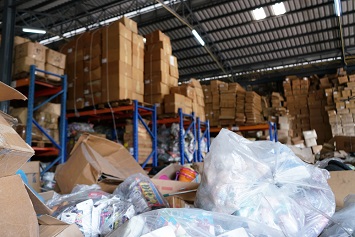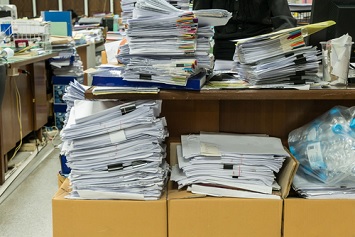What did you see when you walked into your facility this morning? Were there cords snaking across the floor, remnants of a spill from a couple of days ago, or overflowing trash cans? Or did you observe a strong sense of order, with clear walkways, properly stored tools, well-lit and clearly marked stairways, and hazardous materials properly stored and labeled? If there were clutter problems, did you continue to ignore them? We hope not, as messes, and the risks they pose, do matter.
It was recently reported that conditions in the back rooms of some Target retail stores have become unsafe due to clutter, and a messy facility has implications beyond the negative impact on the perceptions of both clients and employees. Depending on the type of clutter present at your facility, your workers may be at risk of illness, injury, or even death. The good news is that you don’t need to be Marie Kondo to deal with clutter. We’ll examine some of the negative impacts clutter can have on your business and provide some tips for overcoming the mess.
Indoor Air Quality
Studies continually show that indoor air quality dramatically affects the health and wellness of workers. While it’s easy to assign blame to indoor air pollutants when there is an obvious cause—such as tobacco smoke and fumes from painting or staining, welding, sanding, or hanging drywall—there are numerous air quality issues that can be hidden or exacerbated by clutter.
Mold, for instance, can easily thrive in a cluttered facility. There are many types of molds that can grow on the materials found in every building: wood, carpet, drywall, insulation, and paper. The only requirements for mold are moisture and oxygen.
While a roof leak, for example, in a clean facility might be noticed and addressed quickly, there’s a higher chance that it will remain hidden in a cluttered space. In addition to obscuring the problem, the clutter will interfere with the flow of air from the heating, ventilation, and air conditioning (HVAC) unit. The moisture is effectively trapped, allowing humidity to build up and creating conditions where mold thrives.
Addressing Air Quality Issues
The U.S. Environmental Protection Agency (EPA) has a few tips for dealing with poor air quality in your buildings:
- Address the source of the indoor air pollutants directly; this could be as simple as removing clutter or patching a leaky roof or as complex and expensive as asbestos removal.
- Improve ventilation by regularly inspecting and servicing your HVAC unit or by replacing faulty or broken systems. Removing clutter will also allow for better airflow.
- Depending on the type of work at your facility, you may need to install a dedicated air-cleaning unit to remove particulate matter or harmful fumes.
Slips, Trips, and Falls
Slips, trips, and falls continue to be among the leading causes of workplace injuries, collectively costing companies billions of dollars in workers’ compensation and/or liability damages (not to mention increased premiums) every year. Many of these injuries could be prevented simply through good housekeeping procedures.
Eliminate general clutter, loose cords, hoses, and wires, along with improperly used floor mats, by:
- Using wall-mounted storage hooks, shelves, and hose spools;
- Marking walkways and keeping them clear of boxes, paperwork, or other loose items;
- Covering cords on the floor with a beveled protective cover;
- Providing mats and runners large enough so that users can take several footsteps on them, thereby cleaning contaminants off their shoes before the shoes contact the flooring;
- Using beveled-edge, flat, and continuous or interlocking mats; and
- Replacing mats that are curled, ripped, or worn (secure edges with carpet tape if needed).
Once everything is in its place, it’s important to keep it that way through implementing good housekeeping protocols. Employees and maintenance staff should be required to:
- Clean up all spills immediately.
- Plainly mark spills and wet areas before they are cleaned up or dry up.
- Sweep or mop debris from floors.
- Remove obstacles from walkways, and keep them free of clutter.
- Secure mats, rugs, and carpets that do not lie flat.
- Close all file cabinets and storage drawers consistently.
- Cover cables that are placed over walkways.
- Keep working and walking areas well lit.
Maintenance policies and practices, proper flooring, appropriate footwear, and awareness training for employees are easy ways to make a good impression on your clients or customers and to avoid unnecessary workers’ compensation claims or a lawsuit from an injured visitor.
Fire Hazards
There is general agreement among experts that most workplace fires are the result of human error. This is good news! It means that EHS managers have numerous tools at their disposal that they can use to help prevent a fire in their workplace. While policies, procedures, and training are key in addressing fire hazards, good housekeeping is equally important.
Here are some tips for preventing fires at your organization:
- Store materials safely, and keep storage areas well ventilated and free of ignition sources.
- Regularly check electrical circuits, outlets, wires, and plugs. Make sure equipment or small appliances are turned off at the end of the shift or workday.
- Dispose of waste promptly and properly.
- Educate employees about the risks posed by clutter, and require them to follow housekeeping policies and procedures.
- Service machines regularly. Establish a regular maintenance schedule, and make sure it is followed.
- Provide proper fire extinguishers for the hazards in your work areas. Check regularly to make sure the devices are charged.
- Inspect regularly all areas for fire hazards, paying particular attention to places where fires are most likely to occur.
- Enforce fire safety and prevention rules, which includes your no-smoking policy. Develop discipline procedures for those who break the rules.


